You are visiting my author website, which includes my first two books and a more personal look at who I am. If you’re looking for the most current information on what I’m working on, including board and advisory work, please visit my business website, thegrayrhino.com. You can also find a more traditional bio there.
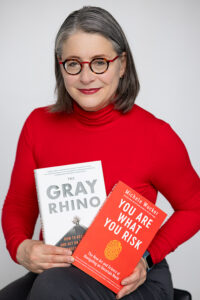
The first writing assignment I gave to master’s students at Columbia University’s School of International and Public Affairs each semester was to write a short “about me” essay using stories to show how their lives led them to write about the topic they’d chosen for the semester. I wanted to get them away from the hackneyed “I have a passion for…” declarations I’d seen in all too many cover letters from would-be policy wonks seeking jobs at the World Policy Institute, the New York City-based global think tank I ran for seven years.
I wanted them to stop merely reciting lists of accomplishments as they, had been rewarded for doing, just as I had been when I was a student. Instead, I wanted them to understand how their own stories drove their choices of careers and of issues they championed. By giving readers a sense of the experiences and emotions that motivated them, my students could increase the power of their writing. Stories are powerful: they help readers to connect to an issue both by seeing the human side, and in envisioning what might happen if governments, organizations, and individuals chose different policies. By understanding how stories worked, my students could write not merely “about” a topic, but in ways that could catalyze real world change.
Then it occurred to me that I was telling my students to do as I said, not as I did, when I talked about myself. There’s a time and a place for what-I-do-and-have-done lists, so you can find my “official” bio page here: Bio or check me out on LinkedIn. But here, I want to follow the advice I gave my students and give you a real sense of how I became “me.”
Ask me where I’m from and the best answer I can give is, “It’s complicated.” I was born in Kansas City, Missouri. My family is from Wisconsin, where I lived in middle school and again after college as a reporter for the Milwaukee Sentinel. I became an adult in Texas, which gave me an appreciation for manners, Southern hospitality, Tex-Mex food, and tall tales. Living in New York City for 23 years gave me a big-city edge and an addiction to the fast lane, from which I am recovering. But I’m a Midwesterner at heart: practical, optimistic and a big fan of gratuitous acts of kindness.
In 2014, I moved to Chicago because it was time to get back to my roots, as they say. This city is both new and familiar: Though I had never lived here before, I had visited Chicago nearly every year of my life and keep discovering bits of my own family’s history –for example, at the downtown hotels where my great-grandmother, who immigrated from Poland, and great-grandfather, who immigrated from Bohemia, worked and met early in the twentieth century. They moved to Milwaukee and started a restaurant. Unfortunately, my great-grandfather died in the second wave of the 1918 Great Flu pandemic.
My family’s immigration history spans the Great Wave of the early twentieth century, the mid-nineteenth century exodus of German political dissidents, and the period immediately after World War II. My mother’s father was an American GI who fell in love with a young Belgian woman who delivered messages for the resistance. They came back to Milwaukee when my mother was three years old. My dad’s family came from the Burgenland region of Southeastern Austria and from across the Austro-Hungarian Empire early in the twentieth century. I’m not sure what generation immigrant that makes me, but I do know that my family history gave me a global perspective and shaped the questions that have driven my career.
My mother wasn’t allowed to speak French with her Belgian mother when they first moved to the United States. To right that wrong, she taped index cards with French translations into my children’s books. When I was 16, I spent a month in Belgium with my relatives and a month in Germany on an exchange program. My mom’s family lived in a Flemish suburb of Brussels, which got me interested in the politics of language. I studied cultural conflict as an undergraduate at Rice University and won a fellowship to spend the summer in the Dominican Republic and Haiti to learn about the tensions between those two countries sharing an island and very different legacies from Spanish and French occupations.
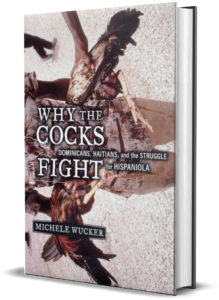 That summer in Santo Domingo and Port-au-Prince, as the Latin American debt crisis raged, I saw how politicians used language and culture to mask other issues, particularly poverty, corruption, immigration and economic crisis. The time I spent on Hispaniola led to work writing about immigration for the Milwaukee Sentinel and several other publications. It also inspired my first book, Why the Cocks Fight: Dominicans, Haitians, and the Struggle for Hispaniola, published in 1999, taught in many universities and still in print. In 2018, Bronx Community College chose it as their “One Book” of the year, making it the focal point of conversations in classes and events across campus. Sadly, its message is all too timely today.
That summer in Santo Domingo and Port-au-Prince, as the Latin American debt crisis raged, I saw how politicians used language and culture to mask other issues, particularly poverty, corruption, immigration and economic crisis. The time I spent on Hispaniola led to work writing about immigration for the Milwaukee Sentinel and several other publications. It also inspired my first book, Why the Cocks Fight: Dominicans, Haitians, and the Struggle for Hispaniola, published in 1999, taught in many universities and still in print. In 2018, Bronx Community College chose it as their “One Book” of the year, making it the focal point of conversations in classes and events across campus. Sadly, its message is all too timely today.
As an opening epigraph for Why the Cocks Fight, I used this epigraph from the legendary anthropologist, Clifford Geertz, in his classic essay, “Deep Play: Notes on a Balinese Cockfight“: “What the cockfight says it says in a vocabulary of sentiment–the thrill of risk, the despair of loss, the pleasure of triumph. Yet what it says is not merely that risk is exciting, loss depressing, or triumph gratifying, banal tautologies of affect, but that it is of these emotions, thus exampled, that society is built and individuals are put together.” Many years later, that statement would influence my work on risk.
My time in the Dominican Republic and Haiti also sparked my interest, first as a master’s student at Columbia University’s School of International Affairs and later as a journalist at Dow Jones and International Financing Review, in finance and development. I wrote about Argentina’s financial problems, particularly a proposal in early 2001 for banks to write down about a third of what Argentina owed, in order to prevent bigger losses later. Bankers told me that they agreed that was the best course of action, but couldn’t say so publicly. Of course, nine months later the country collapsed. The lessons of that crisis and lost opportunity would come to play a major role in the work I do today on global risk and response.
Combining my expertise in economics and finance with my interest in immigration, I published my second 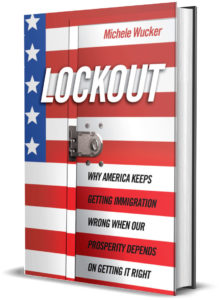 book, Lockout: Why America Keeps Getting Immigration Wrong When Our Prosperity Depends on Getting It Right, in 2006. I also (mostly) put down the journalist’s pen and moved to the policy world, eventually leading the World Policy Institute after it nearly closed, and returning it to its status as an independent organization after 16 years when it was part of The New School, a New York University.
book, Lockout: Why America Keeps Getting Immigration Wrong When Our Prosperity Depends on Getting It Right, in 2006. I also (mostly) put down the journalist’s pen and moved to the policy world, eventually leading the World Policy Institute after it nearly closed, and returning it to its status as an independent organization after 16 years when it was part of The New School, a New York University.
A decade after Argentina’s collapse, Greece faced a new debt crisis in the aftermath of the global financial collapse. Greece threatened to bring down the European Union with it. I wrote about Argentina’s cautionary tale in a 2011 paper for New America. Nearly a year later, with the clock ticking, Greece’s private sector creditors agreed to write down much of its debt, bringing the country back from the edge and preventing what could have been a catastrophic domino effect.
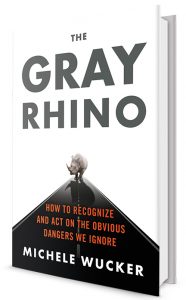 That led me to my third book, The Gray Rhino: How to Recognize and Act on the Obvious Dangers We Ignore, published in 2016 by St Martin’s Press. The book explores why some leaders and organizations are able to acknowledge seemingly obvious problems and act in time to address them; why it’s far more common to ignore the most predictable, probable threats; and how, once we understand those “whys,” how we can do better at dealing with instead of denying looming crises. I’ve now returned full time to writing, speaking, and strategy after spending too many years away from what I love most. I created Gray Rhino & Company in 2015 to help organizations and individuals to apply gray rhino thinking to transforming obvious threats into opportunities. That involves keynote speeches, workshops, digital media, education, and advisory work.
That led me to my third book, The Gray Rhino: How to Recognize and Act on the Obvious Dangers We Ignore, published in 2016 by St Martin’s Press. The book explores why some leaders and organizations are able to acknowledge seemingly obvious problems and act in time to address them; why it’s far more common to ignore the most predictable, probable threats; and how, once we understand those “whys,” how we can do better at dealing with instead of denying looming crises. I’ve now returned full time to writing, speaking, and strategy after spending too many years away from what I love most. I created Gray Rhino & Company in 2015 to help organizations and individuals to apply gray rhino thinking to transforming obvious threats into opportunities. That involves keynote speeches, workshops, digital media, education, and advisory work.
In Spring 2017, The Gray Rhino was published in China, where it quickly became an influential best-seller that the country’s leaders have used to frame, strategize, and communicate policy priorities from financial risk to securing food and natural resources. President Xi Jinping displays my book in his office and has referred to gray rhinos often in private and in a widely publicized January 2019 speech. Whenever you hear a senior Chinese official refer to an issue as a gray rhino, you need to pay attention.
On my book tour in the US, Europe, and China, I was struck by how many people asked about how to apply gray rhino theory to their personal lives. So I developed a response in my 2019 TED talk applying gray rhinos to personal challenges, which has received more than 2.5 million views… and counting.
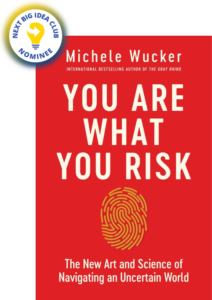 Inspired by readers, my newest book, YOU ARE WHAT YOU RISK: The New Art and Science of Navigating an Uncertain World (Pegasus Books, April 2021) takes a much more personal look at what makes each one of us likely to embrace, avoid, or confront the risks we face. It shows how culture, values and societal norms interact with our innate personality, the experiences that shaped us, the social context, and the habits we can develop to make better risk decisions. And it provides a new vocabulary for thinking and talking about risk: when risk savvy is a more appropriate term than risk aversion, how risk empathy can improve your teamwork and relationships, and why risk literacy is essential to healthy risk ecosystems.
Inspired by readers, my newest book, YOU ARE WHAT YOU RISK: The New Art and Science of Navigating an Uncertain World (Pegasus Books, April 2021) takes a much more personal look at what makes each one of us likely to embrace, avoid, or confront the risks we face. It shows how culture, values and societal norms interact with our innate personality, the experiences that shaped us, the social context, and the habits we can develop to make better risk decisions. And it provides a new vocabulary for thinking and talking about risk: when risk savvy is a more appropriate term than risk aversion, how risk empathy can improve your teamwork and relationships, and why risk literacy is essential to healthy risk ecosystems.
The gray rhino struck a new global chord with the COVID19 pandemic and economic crisis. There were many warnings ahead of time about the world’s lack of preparedness for the next pandemic and about the wobbly house of cards that passed for financial markets. As people recognize the cost of ignored warnings and slow responses, the global media has embraced the gray rhino anew. The UK’s Crisis Response Journal has called the gray rhino “a metaphor for our times,” while New Model Advisor magazine put the gray rhino on the cover. The Wall Street Journal quoted my Washington Post article “No, the coronavirus pandemic was not an ‘unforeseen’ problem.” I’m continuing to push for decision makers to adopt a more proactive response to the obvious problems that we are all too likely to ignore –and I hope that you’ll help!
Looking at my earlier career as a journalist, author and think tank executive at the World Policy Institute, Chicago Council on Global Affairs, International Financing Review and Dow Jones, it may seem like a puzzle to pull together a cohesive story (and if you’re looking at this page during research, PLEASE don’t identify me primarily by my former life). My research interests are varied: on immigration, emerging markets bonds, sovereign debt crisis, citizenship, the global economy, governance, women’s leadership, and facing inequality and climate challenges head-on.
Finding the threads among seemingly disparate but connected stories is part of a day’s work for the best journalists, but please don’t call me a journalist because my work is very different from what I was taught journalists do. I’m happiest when making connections across issues, analyzing how complex problems interact and strategizing policy and business solutions. I also love to help others to understand complex concepts and apply them to solving the challenges they face.
And while I’ve built my career around thinking about policy, I’m not too much of a wonk; at least I hope I’m not! I believe that policy is too important to be left to Washington and bureaucrats. I believe in policy based on facts, but understand how much emotions come into play in the decisions that governments and businesses make, and in the everyday decisions each one of us makes that affect others around us. Policy is for everyone. So I hope that the biggest impact of my work is to make accessible and relevant the issues that have been compelling to me and, in the process, to engage others in making our world a better place.
My work today continues to focus on risk –specifically, helping people to understand why it’s so important to take a fresh look at the obvious, probable dangers and opportunities right in front of us. That includes better understanding what’s behind individual decision making, organizational governance, and policy ecosystems, and how these work together to encourage smart (or not-so-smart) risk taking. Through speaking engagements, workshops, digital courses, private presentations, and strategic advisory services all around the world, I apply my gray rhino and risk fingerprint forensic frameworks to the challenges we ignore only at our peril. You can find out more and engage me on my business website, thegrayrhino.com, or LinkedIn profile.